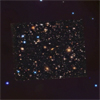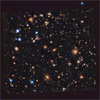Correction: After this paper (Treister et al. 2011) was published and publicized a problem was discovered with the background subtraction used. Analysis by several groups, including the Treister et al. team, plus Willott (2011) and Cowie et al. (2012), shows that a significant detection of AGN (growing black holes) in the early universe can no longer be claimed.
Editor's Note: Honest errors such as this are part of the scientific process, especially on the frontiers of discovery. To quote Nobel laureate Frank Wilczek, "If you don't make mistakes, you're not working on hard enough problems. And that's a big mistake."
References:
Cowie, L. et al. 2012, ApJ, in press
http://lanl.arxiv.org/abs/1110.3326
Treister, E. et al. 2011, Nature, 474, 356
http://lanl.arxiv.org/abs/1106.3079
Willott, C. 2011, ApJ, 742, L8
http://lanl.arxiv.org/abs/1110.4118
Quicktime MPEG
This image is what is known as the Chandra Deep Field South, a 4-million-second exposure made by NASA's Chandra X-ray Observatory. Located in the constellation of Fornax, this is the deepest X-ray image ever obtained of the sky. Most of the sources in this image contain rapidly growing supermassive black holes. Some of these black holes are seen to exist when the Universe is less than about 950 million years old.
[Runtime: 00:39]
(Credit: X-ray: NASA/CXC/U.Hawaii/E.Treister et al; Infrared: NASA/STScI/UC Santa Cruz/G.Illingworth et al; Optical: NASA/STScI/S.Beckwith et al)
Quicktime MPEG
This animation shows an artist's impression of a distant galaxy and its hidden black hole found in an epoch when the Universe was less than one billion years old. The galaxy contains regions of active star formation (blue) and large amounts of gas and dust (red). The view zooms into the galaxy, and a glowing disk of hot gas falling onto massive central object is seen. At the center of the disk is a supermassive black hole. Many types of radiation emitted from the disk are blocked by the veil of dust and gas, but very energetic X-rays are able to escape. Scientists found many of these black holes in the early Universe using the new Chandra Deep Field South.
[Runtime: 00:20]
(Credit: NASA/CXC/A. Hobart)
Stills:
Quicktime MPEG
This sequence of images begins with a large optical image of the southern sky. The view zooms into the 4-million-second exposure of the Chandra Deep Field South, and then an optical and infrared image from the Hubble Space Telescope is overlaid. The Chandra sources are blue in this composite image. After further zooming in, yellow circles appear to mark the positions of very distant galaxies that existed when the Universe was less than about 950 million years old. The two small Chandra sources on the right show that all of the low and high energy X-rays that have been added up at the positions of these galaxies. This provides evidence that growing black holes have been detected in 30% to 100% of the distant galaxies.
[Runtime: 00:27]
(Credit: X-ray: NASA/CXC/U. Hawaii/E. Treister et al; Infrared: NASA/STScI/UC Santa Cruz/G. Illingworth et al; Optical: Wide-field: Akira Fujii; Close-up: NASA/STScI/S. Beckwith et al)
Return to Chandra Deep Field South (June 15, 2011)













